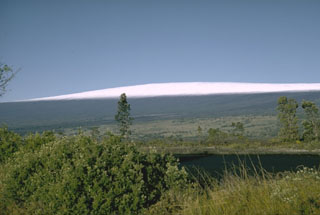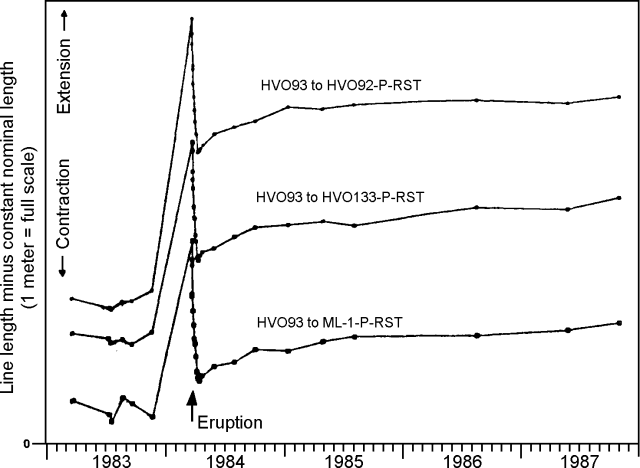Report on Mauna Loa (United States) — October 1987
Scientific Event Alert Network Bulletin, vol. 12, no. 10 (October 1987)
Managing Editor: Lindsay McClelland.
Mauna Loa (United States) Steady post-1984 reinflation eruption but seismicity low
Please cite this report as:
Global Volcanism Program, 1987. Report on Mauna Loa (United States) (McClelland, L., ed.). Scientific Event Alert Network Bulletin, 12:10. Smithsonian Institution. https://doi.org/10.5479/si.GVP.SEAN198710-332020
Mauna Loa
United States
19.475°N, 155.608°W; summit elev. 4170 m
All times are local (unless otherwise noted)
"Mauna Loa's latest eruption was in March-April 1984 on the Northeast rift zone. The eruption was associated with a large collapse (figure 10) and seismicity that peaked during and following the eruption (figure 11). Since 1984 the volcano has begun to reinflate, as shown by outward tilt and horizontal extension of Mauna Loa's summit area.
 |
Figure 11. Daily number of recorded short-period (top) and long-period (middle) summit microearthquakes, and NE rift events (bottom) at Mauna Loa, January 1984-4 November 1987. Courtesy of HVO. |
Seismicity. "Following the increase and peak in seismicity of the last eruption in Mar-Apr 1984, the number of shallow microearthquakes had slowly decreased (figure 11). Most of the post-eruption events were attributed to the gradual structural adjustments from the major deflation at the summit (resulting from the voluminous magma withdrawal) and the principal eruptive vent near Pu'u Ulaula on the Northeast rift zone. The post-eruption pattern of decreasing seismicity is indicated by the daily number of summit microearthquakes and Northeast rift events.
"There has been no significant seismic activity beneath the summit and rift zones of Mauna Loa since the 1984 eruption, and the present level of shallow seismicity is relatively low. There has been some increase in intermediate-depth events beneath the volcano noticed over the past year. Most of the events are very small, recorded only on a few summit and rift stations, and essentially < 0.5 in magnitude.
Ground deformation. "Deformation studies show that Mauna Loa reinflation has been steady; at this writing the summit has recovered over 1/3 of the amount of subsidence that took place during the eruption, as measured by both dry tilt and cross-caldera EDM (figure 10).
"A forecast of the next Mauna Loa eruption will depend on two things: an increase in shallow earthquakes and tilt recovery. The last two eruptions showed a precursory period of 1 year (July 1975 eruption) and 4 years (March 1984 eruption) respectively from the time of increased seismicity to the onset of eruption. There is no absolute level of tilt recovery at which we can specify that Mauna Loa will erupt. However, we would consider roughly 90% recovery from the 1984 deflation would indicate a state of readiness to erupt. On the basis of the data shown here we would not expect a Mauna Loa eruption for at least five years. We will update this estimate as we continue to monitor tilt and seismicity . . . ."
Geological Summary. Massive Mauna Loa is a basaltic shield volcano that rises almost 9 km from the ocean floor to form the world's largest Holocene volcano. Flank eruptions typically occur from the lengthy NE and SW rift zones, and from the Moku'aweoweo summit is caldera, which is within an older and larger 6 x 8 km caldera. Two of the youngest large debris avalanches documented in Hawaii traveled nearly 100 km from Mauna Loa; the second of the Alika avalanches was emplaced about 105,000 years ago (Moore et al., 1989). Almost 90% of the surface of the volcano is covered by lavas less than 4,000 years old (Lockwood and Lipman, 1987). Beginning about 1,500 years ago, a series of voluminous overflows from a summit lava lake covered about 25% of the volcano's surface. Over the last 750 years, from shortly after the formation of Moku'aweoweo caldera until the present, an additional 25% of the volcano has been covered with lava flows, mainly from summit and NW rift zone vents.
Information Contacts: T. Wright, R. Koyanagi, and A. Okamura, HVO.


